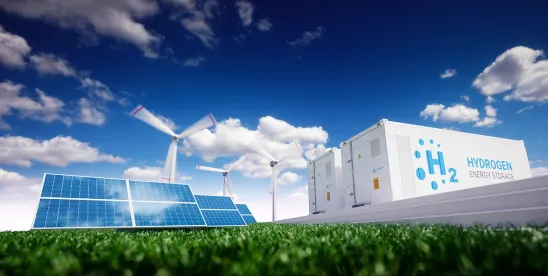The Department of Energy (DOE) is driving an ambitious clean hydrogen initiative with unprecedented speed, aiming to transform the U.S. energy landscape through its Regional Clean Hydrogen Hubs program. The DOE has already made significant progress in selecting and committing funding for key projects across the nation, positioning hydrogen as a cornerstone of the clean energy transition.
However, the two-year delay in the IRS’ promulgation of guidance on the Section 45V tax credit for producing clean hydrogen, which is crucial for the financial viability of many hydrogen production projects, has cast uncertainty over the program’s future. Without clear incentives, investments have stalled, threatening to slow the momentum and potentially derail these projects.
The IRS recently announced plans to issue the final Section 45V rule by the end of 2024. It is crucial for the IRS to meet that self-imposed deadline and strike a workable balance between economic support for hydrogen production and environmental responsibility, in order to overcome these financial hurdles and clear a path for hydrogen to meet its transformative potential in decarbonizing the nation’s energy sector.
DOE Continues to Advance the Development of H2Hubs at a Record Pace
This past year, the DOE has continued its lightning fast (from a governmental perspective) implementation of the administration’s June 2023 National Clean Hydrogen Strategy and Roadmap to accelerate the production, processing, delivery, storage, and use of clean hydrogen. This strategy is key to achievement of the administration’s Hydrogen Shot and its ambitious goals for the U.S. to reduce greenhouse gas (GHG) pollution from 2005 levels by 50 percent to 52 percent by 2030 under the Paris Agreement, create a carbon pollution-free power sector by 2035, and reach net-zero emissions no later than 2050.
The centerpiece of this strategy is the DOE program, funded by $8 billion from the Bipartisan Infrastructure Law (BIL), to establish Regional Clean Hydrogen Hubs (H2Hubs) that will form a national network of clean hydrogen producers to accelerate the use of hydrogen as a large-scale clean energy carrier.
After an accelerated and intense application process, in October 2023, the DOE selected the seven H2Hubs that would share $7 billion of that funding, with the remaining $1 billion designated for demand-side incentives to facilitate the early purchase of hydrogen for commercial and consumer applications.
In July 2024, the DOE’s Office of Clean Energy Demonstrations’ (OCED) completed contract negotiations with three of the H2Hubs and began awarding funds for work on Phase 1 to solidify planning, development, and design activities around site selection, technology deployment, community benefits and engagement, labor partnerships, and workforce training.
These initial planning awards have been made to the Appalachian (ARCH2), California (ARCHES) and Pacific Northwest (PNWH2) H2Hubs. The DOE hopes to reach final agreements with the other four H2Hubs this year.
Financial Uncertainty Over Section 45V Tax Credits Holding Back Domestic Hydrogen Production
Notwithstanding this extraordinary progress on the programmatic side, financial commitments to proceed with hydrogen projects have been stymied by the U.S. Department of Treasury and IRS’ delay in issuing draft and final regulations for the Inflation Reduction Act of 2022 (IRA) tax credits that are critical to the financial viability of the H2Hubs and other supporting projects. This financial uncertainty has been further exacerbated by the controversies that have arisen over the proposed regulations for the Section 45V tax credit for production of clean hydrogen that have not yet been addressed by the agencies more than two years after IRA was enacted.
Section 45V gives qualified projects that begin construction before 2033 a tax credit for 10 years after startup with up to a $3 credit per kilogram. The level of the credit is based on carbon production intensity. For example, to secure the maximum Section 45V credit, the clean hydrogen production process has to emit 95 percent less CO2 than hydrogen produced by fossil fuels, and must meet prevailing wage and registered apprenticeship requirements. This maximum potential credit is the largest hydrogen production incentive offered by any nation.
While the DOE was pressing forward, the Treasury Department and the IRS missed the Aug. 23, 2023, statutory deadline for issuing guidance on how a facility qualifies for the Section 45V credit and determines the amount of credit it receives. The draft rulemaking that set forth the proposed guidance was released on Dec. 23, 2023. This guidance, which focused on three pillars that would need to be met to secure maximum credit – additionality, deliverability/regionality, and time matching – immediately provoked heated debate.
Although a bit of an oversimplification, supporters of the proposal have focused on a perceived need to use renewable clean energy from newer sources (that minimize indirect carbon emissions) within the region where the facility producing the hydrogen is located in order to secure the largest credits.
Critics, in turn, have asserted that the proposed guidelines and stringent three pillars approach do not follow the Congressional direction in the IRA to provide the substantial economic support and flexibility needed to timely develop an enduring domestic hydrogen market. The objectors assert that by effectively precluding the availability of the maximum incentives to many prospective hydrogen producers, the proposal (if finalized) will deter building the hydrogen capacity needed to meet climate goals.
More than 30,000 comments on the rule were submitted and more than 100 witnesses commented in person at a two-day IRS public hearing in March 2024. Proponents included a broad spectrum of political, commercial and environmental stakeholders. Opposing commenters represented a similarly wide range of interests, and notably included the DOE and all seven of the selected H2Hubs.
While proponents and opponents have continued to stake out their positions (even after the comment period ended) there also has been a call for adjustments to rebalance and align the economic viability and cost-effectiveness of hydrogen production with environmental preservation goals.
While paper progress on the H2Hubs has proceeded, because of the continuing financial uncertainty, a number of investment commitments are on hold and hydrogen production projects have been delayed.
Will the Final 45V Guidance Be Too Little Too Late?
Nine months after the proposed rule was issued, with no final action in sight, 66 Democratic members of Congress sent a letter on Sept. 12 to Treasury Secretary Janet Yellen, Energy Secretary Jennifer Granholm, and EPA Administrator Michael Regan defending the three pillars, rejecting opponents objections and proposed modifications and exemptions, and asking for finalization of the guidance consistent with the draft proposal.
Less than a month later, on Oct. 1, Aviva Aron-Dine, performing the duties of assistant secretary for tax policy, issued a statement regarding the status of and plans for issuance of guidance regarding the IRA’s climate and clean energy provisions. She related that: “Between now and the end of this Administration, we will continue to provide rules of the road and certainty to help make the IRA tax policies even more effective in reducing greenhouse gas emissions, supporting the development of clean energy industries of the future and the deployment of clean energy solutions across every sector of the economy”
With respect to Section 45V in particular, Aron-Dine also said:
We also know that clean hydrogen will be critical for reducing emissions from hard-to-decarbonize sectors in heavy industry, and we recognize that the clean hydrogen industry needs certainty. We intend to finalize rules for the section 45V Clean Hydrogen Production Credit by the end of the year. As we continue to review and evaluate the nearly 30,000 comments received on the proposed rules, we are working to include appropriate adjustments and additional flexibilities to help grow the industry and move projects forward, while adhering to the law’s emissions standards, including the requirement to consider indirect emissions. (emphasis added)
While this is welcome news to the stakeholders, it begs the question whether issuing the final Section 45V hydrogen production tax credit rule more than two years after the IRA is too little too late. If the recent past is prologue, it is likely that both supporters and objectors will seek judicial review. Also, given the recent Supreme Court decisions in Loper Bright and Corner Post, it is far from clear that H2Hub developers (and their financing sources) will have the patience and resources to outlast the uncertainty and adapt to the outcome.
Additionally, even if the final rule is not challenged in court, if there is a change in administration after the upcoming election, the guidance will be subject to being overturned under the Congressional Review Act. This added potential for uncertainty can be a further deterrent for developers and financing sources.
Conclusion
As the DOE continues to make significant progress on its clean hydrogen initiatives, the urgency for final Section 45V guidance grows. The promise of final Section 45V tax credit regulations by year-end brings cautious optimism, but the delays have already stalled critical investments in hydrogen projects. Whether the IRS can meet this deadline with a final guidance that strikes the right balance between economic viability and environmental goals remains to be seen.
Without clear and timely direction, the financial uncertainties surrounding hydrogen production could derail key projects and stall the broader adoption of hydrogen as a clean energy solution. The stakes are high – not only for the success of the H2Hubs but for the nation's ability to meet its ambitious decarbonization targets. Overcoming these financial roadblocks will be essential to unlocking the full potential of hydrogen and ensuring the U.S. remains a leader in the global energy transition.




 />i
/>i

